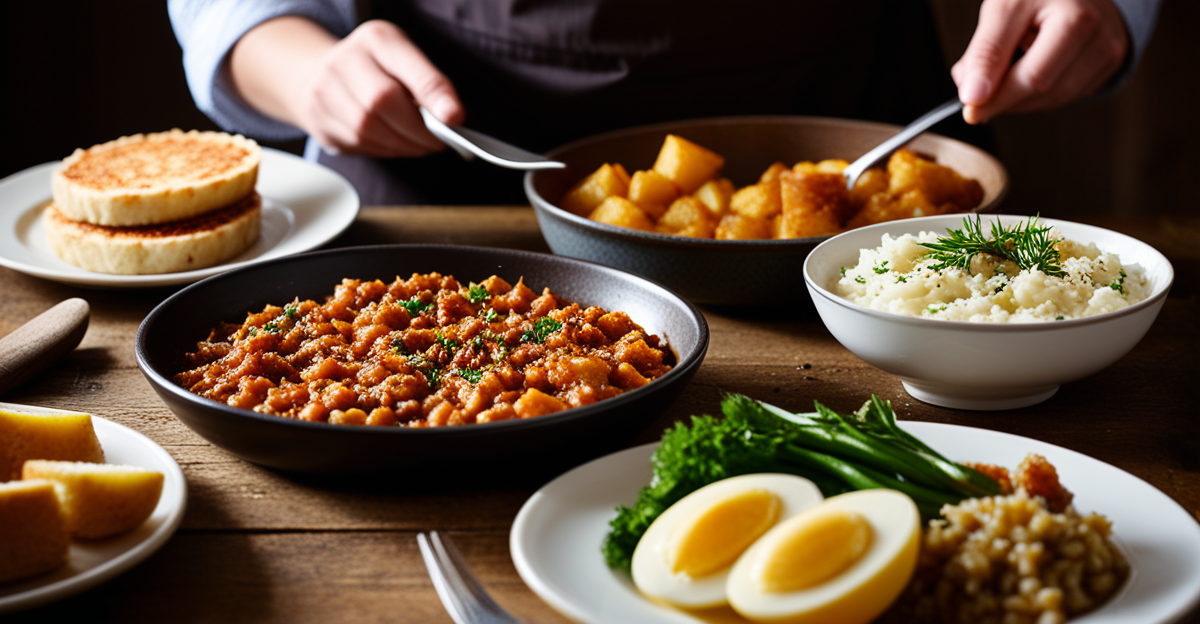Essential Characteristics of Beginner-Friendly British Dishes
When exploring easy British recipes, certain traits consistently appear in beginner British cooking. Traditional British food characteristics often include straightforward preparation, reliance on staple ingredients, and simple cooking methods like baking, boiling, or frying. These dishes rarely require complex techniques, making them well suited to newcomers. For example, dishes often incorporate familiar elements such as potatoes, bread, or dairy, which help ease the cooking process.
Basic techniques—like sautéing onions, simmering stews, or making a simple sauce—are foundational in traditional British food. Mastering them through easy recipes builds essential skills. This approach also reduces the risk of failure, fostering a positive kitchen experience for beginners.
Additional reading : How Can English Cuisine Enhance Your Health?
Additionally, these dishes focus on hearty, comforting flavors rather than exotic or overly spicy profiles, aligning with home-cooking sensibilities. As a result, beginner British cooking encourages confidence not only through achievable results but also by introducing cooks to a reassuring, time-tested culinary tradition. Learning classic British dishes offers a gratifying start for anyone wanting to develop their skills without intimidation.
Top Traditional British Dishes Ideal for Beginners
Exploring easy traditional British dishes provides a practical path for those new to British cooking. Among British recipes for beginners, several stand out for their simplicity and flavor, making them perfect entry points.
Additional reading : How do you prepare a traditional bubble and squeak with a twist?
One classic is Shepherd’s Pie, a hearty dish combining minced meat with mashed potatoes. It’s straightforward, requiring just basic stovetop and oven skills. Another favourite is Bangers and Mash—sausages paired with creamy mashed potatoes. The preparation involves simple frying and boiling techniques, ideal for beginner cooks.
For a fun twist, Toad in the Hole consists of sausages baked in a Yorkshire pudding batter, offering hands-on experience with batter preparation and baking. Meanwhile, Fish Fingers and Chips can be an approachable way to practice frying and create a crispy finish.
These dishes emphasize familiar ingredients and uncomplicated methods, aligning perfectly with what beginner British cooking demands. They build essential skills such as frying, baking, and assembling components, boosting confidence in the kitchen.
Starting with these simple UK recipes ensures that learners grasp foundational cooking elements while enjoying rewarding, traditional British flavours that succinctly illustrate the cuisine’s comforting appeal.
Essential Characteristics of Beginner-Friendly British Dishes
When approaching beginner British cooking, one quickly notices that many easy British recipes share key features that make them approachable. These dishes rely on basic techniques like simmering, baking, or simple frying. This simplicity allows novices to focus on mastering foundational cooking skills without feeling overwhelmed.
One defining trait is the use of familiar, accessible ingredients. Vegetables like potatoes, carrots, and onions, along with common proteins such as minced beef or sausages, create a comforting and manageable ingredient list. This accessibility reduces the need for specialist products, easing the shopping experience—critical for those new to cooking.
Traditional British food characteristics often emphasize hearty portions and straightforward seasoning, which lets natural flavors shine without complex spices or techniques. As a result, these dishes boost confidence in beginners by providing satisfying results with less risk of mistakes.
Understanding these features helps beginners select dishes that promote kitchen success. Starting with easy British recipes ensures that progress feels rewarding, encourages continual learning, and builds a reliable cooking foundation for exploring more diverse British cuisine.
Essential Characteristics of Beginner-Friendly British Dishes
Easy British recipes share key features that make them approachable for new cooks. Traditional British food characteristics emphasize simplicity in ingredients and methods. Dishes often revolve around widely available staples such as potatoes, bread, and dairy, which reduces unnecessary complexity. This familiarity helps beginners avoid feeling overwhelmed when selecting ingredients and preparing meals.
Basic culinary techniques are fundamental to beginner British cooking. Learning skills like frying sausages, boiling potatoes, or simmering stews through easy British recipes equips cooks with practical expertise. Using straightforward cooking methods such as baking or boiling aligns well with these dishes, promoting a smooth learning curve.
Moreover, these recipes focus on hearty, mild flavours rather than adventurous or exotic tastes. This ensures dishes deliver comfort and satisfaction with minimal guesswork. By mastering these traditional British food characteristics, beginners build confidence steadily. Each successful attempt encourages further exploration, transforming simple meals into rewarding learning experiences. Ultimately, this combination of accessible recipes and foundational techniques supports culinary development while honoring Britain’s cherished food traditions.
Essential Characteristics of Beginner-Friendly British Dishes
Easy British recipes share several common traits that make them ideal for beginners. Central to traditional British food characteristics is the reliance on basic techniques such as boiling, baking, and simple frying. These methods are manageable for newcomers and build foundational cooking skills without overwhelming complexity.
Another defining feature is the use of familiar ingredients. Root vegetables like potatoes and carrots, along with common proteins such as sausages or minced meat, provide a straightforward ingredient list that’s easy to source and prepare. This familiarity reduces barriers and encourages experimentation in the kitchen.
These dishes typically focus on hearty, well-balanced flavours without complex seasoning, allowing beginners to appreciate natural tastes while gaining confidence. Because easy British recipes avoid time-consuming steps or hard-to-find components, they reduce stress and promote success.
By practicing these simple dishes, beginner British cooking helps novices develop practical skills and a positive mindset. This confidence makes exploring more challenging traditional British food characteristics less daunting and fosters a rewarding culinary journey.
Essential Characteristics of Beginner-Friendly British Dishes
Easy British recipes embody key traditional British food characteristics that make them highly accessible for beginner British cooking. Central to these dishes is the reliance on basic culinary techniques such as boiling, frying, and baking. These straightforward methods reduce complexity, allowing new cooks to focus on gaining practical skills without feeling overwhelmed.
Familiar ingredients also play a pivotal role. Staples like potatoes, onions, sausages, and dairy appear frequently, providing an ingredient list that’s not only easy to source but also comforting and recognizable. This simplifies shopping and preparation, crucial for those starting out with beginner British cooking. By working with common pantry items, beginners can avoid the confusion sometimes caused by exotic or rare ingredients.
Another important feature is how these recipes build kitchen confidence. Because easy British recipes emphasize hearty yet mild flavors, they minimize the risk of seasoning errors. Preparing these dishes encourages beginners to practice key techniques repeatedly, reinforcing skills while delivering satisfying, traditional results. Over time, this combination of simple methods, familiar ingredients, and encouraging flavors cultivates both competence and enthusiasm in the kitchen.
Essential Characteristics of Beginner-Friendly British Dishes
Easy British recipes share specific traits that make them particularly welcoming for novice cooks, capturing traditional British food characteristics. First, these dishes typically rely on basic culinary techniques such as boiling, baking, and simple frying. These methods require minimal specialized skills but provide an excellent foundation in cooking principles essential for beginner British cooking.
Secondly, the ingredient list is deliberately kept simple and familiar. Common staples like potatoes, carrots, sausages, and minced meat feature prominently across many easy British recipes. This helps reduce ingredient sourcing challenges and streamlines preparation, making cooking more accessible to beginners. Using ingredients that are widely available ensures new cooks can focus on learning the cooking process instead of hunting down obscure products.
Furthermore, these dishes emphasize hearty flavors that are mild yet satisfying, aligning with traditional British food characteristics. Such straightforward seasoning removes the guesswork and enables beginners to understand how basic flavors come together in a dish. Importantly, this fosters confidence by delivering consistent results with less risk of error.
By combining simple techniques, familiar ingredients, and accessible flavors, beginner British cooking offers a reliable path toward developing skills and a positive kitchen experience, vital for anyone starting their culinary journey.
Essential Characteristics of Beginner-Friendly British Dishes
Easy British recipes consistently showcase traditional British food characteristics that prioritize simplicity and approachability. Central to beginner British cooking are basic techniques such as boiling, frying, and baking. These methods are manageable for novices, requiring minimal equipment and reducing the chance of error. Mastering these fundamentals through easy British recipes lays a solid foundation and encourages gradual skill development.
Familiar ingredients also define these dishes. Staples like potatoes, sausages, onions, and dairy dominate the ingredient list, making shopping straightforward and reducing intimidation. These common components support practical learning by allowing beginner British cooking enthusiasts to focus on preparation and timing rather than sourcing unusual items.
Moreover, such recipes cultivate kitchen confidence. The mild, hearty flavours typical of traditional British food characteristics diminish seasoning worries, enabling beginners to enjoy consistent, rewarding results. Repeated success with easy British recipes reinforces positive cooking habits and inspires experimentation. In this way, beginner British cooking serves not only as an introduction to classic dishes but also as a practical way to develop culinary skills while embracing Britain’s cherished food heritage.









